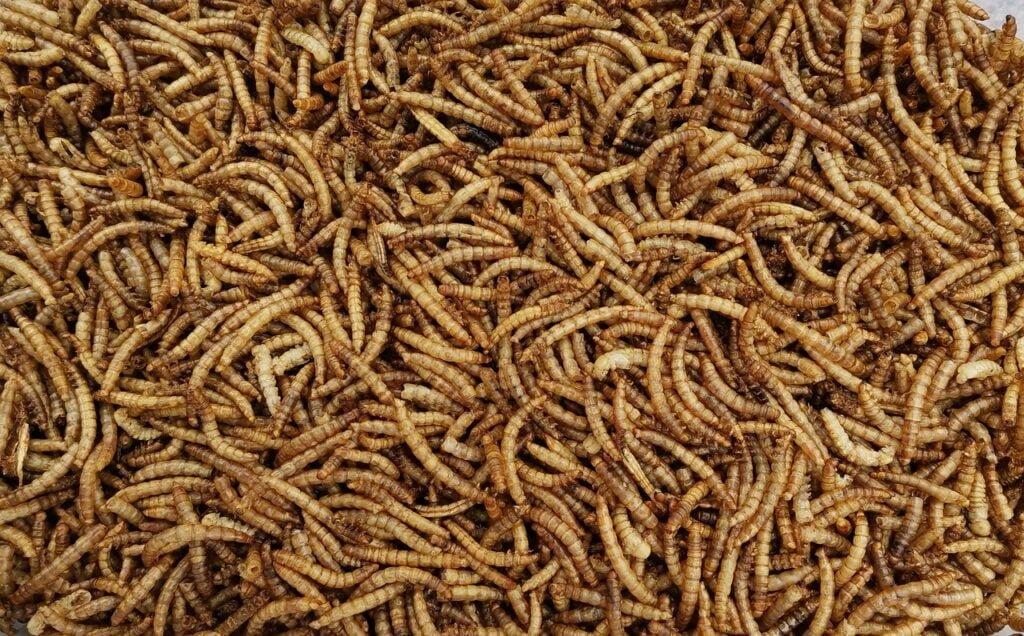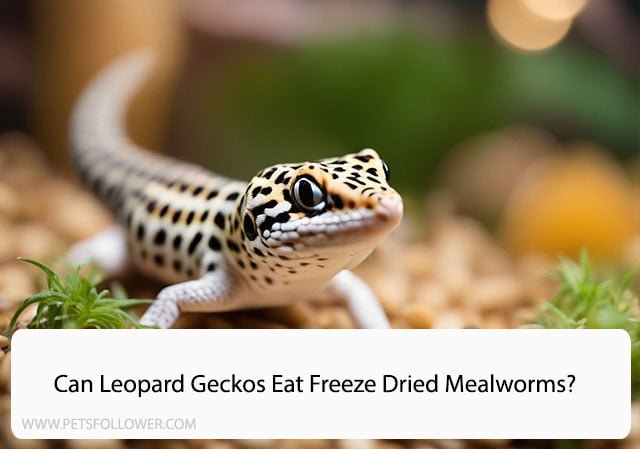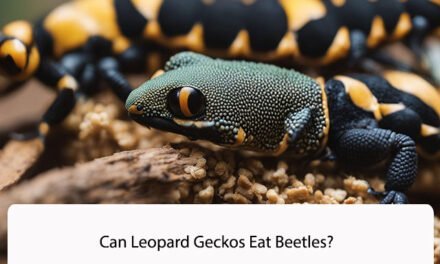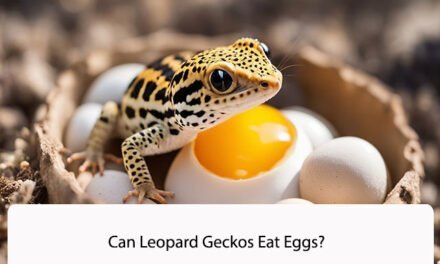Leopard geckos are a popular pet choice for many reptile enthusiasts. These small, docile creatures are known for their unique appearance and easy-to-care-for nature. As with any pet, it’s important to provide proper nutrition to ensure their health and wellbeing. One common question among leopard gecko owners is whether or not they can eat freeze-dried mealworms.

Freeze-dried mealworms are a popular choice for many reptile owners due to their convenience and long shelf life. However, when it comes to leopard geckos, it’s important to consider whether this type of food is suitable for their diet. In this article, we will explore the topic of whether leopard geckos can eat freeze-dried mealworms, and provide you with the information you need to make an informed decision about your pet’s diet.
Nutritional Value of Freeze-Dried Mealworms

Freeze-dried mealworms are a popular food choice for leopard geckos. They are easy to store and have a long shelf life, making them convenient for pet owners. But what is the nutritional value of freeze-dried mealworms?
Firstly, freeze-dried mealworms are high in protein, with around 50% protein content. This makes them an excellent source of protein for leopard geckos, as they require a high protein diet to maintain their health.
In addition to protein, freeze-dried mealworms also contain fat, fiber, and various vitamins and minerals. However, it’s important to note that they are low in calcium. This means that they should not be the sole food source for leopard geckos, as a lack of calcium can lead to health problems such as metabolic bone disease.
To ensure that leopard geckos receive a balanced diet, it’s recommended to supplement freeze-dried mealworms with other food sources such as live insects and calcium-rich foods.
Overall, freeze-dried mealworms can be a nutritious addition to a leopard gecko’s diet, but should not be relied upon as the sole food source. It’s important to provide a varied diet to ensure that leopard geckos receive all the nutrients they need to thrive.
Safety and Health Considerations
When it comes to feeding leopard geckos, it is important to consider their safety and health. While freeze-dried mealworms are a popular choice for many gecko owners, there are some things to keep in mind.
Firstly, it is important to note that freeze-dried mealworms lack the moisture content of live mealworms. This can lead to dehydration in geckos, which can cause health problems. As a result, it is important to ensure that your gecko has access to fresh water at all times.
Additionally, freeze-dried mealworms do not have the same nutritional value as live mealworms. While they are still a good source of protein, they lack the vitamins and minerals that are found in live insects. As a result, it is important to supplement your gecko’s diet with other foods, such as live insects and vegetables.
Finally, it is important to ensure that the freeze-dried mealworms you are feeding your gecko are of high quality. Poor quality mealworms can contain harmful bacteria and parasites, which can cause illness in your gecko. It is important to purchase freeze-dried mealworms from a reputable source and to check the expiration date before feeding them to your gecko.
In summary, while freeze-dried mealworms can be a convenient and nutritious option for feeding your leopard gecko, it is important to consider their safety and health. By ensuring that your gecko has access to fresh water, supplementing their diet with other foods, and purchasing high-quality freeze-dried mealworms, you can help keep your gecko healthy and happy.
Preparing Freeze-Dried Mealworms for Leopard Geckos

When it comes to feeding leopard geckos, freeze-dried mealworms are a convenient and popular option. However, it’s important to properly prepare them to ensure your gecko gets the most nutrition and benefit from them.
Firstly, you’ll need to rehydrate the freeze-dried mealworms. This can be done by soaking them in warm water for 10-15 minutes. Once they have plumped up and become more flexible, you can drain any excess water and they’re ready to be fed to your gecko.
It’s important to note that freeze-dried mealworms should not be the sole source of nutrition for your leopard gecko. They should be offered as a supplement to a varied diet that includes live insects and other appropriate foods.
When feeding freeze-dried mealworms to your gecko, it’s a good idea to offer them in a shallow dish or on a feeding ledge to make it easier for your gecko to access them. You can also dust them with a calcium supplement powder to provide additional nutrition.
Overall, freeze-dried mealworms can be a convenient and nutritious addition to your leopard gecko’s diet when prepared and offered properly.
Feeding Frequency and Portion Sizes
When it comes to feeding freeze-dried mealworms to leopard geckos, it is important to keep in mind the frequency and portion sizes. Leopard geckos are known for their voracious appetite and can easily overeat if given the opportunity. Therefore, it is important to establish a feeding schedule and stick to it.
We recommend feeding adult leopard geckos 3-4 times a week, while juvenile geckos should be fed more frequently, around 5-6 times a week. It is important to monitor their weight and adjust the feeding schedule accordingly. If the gecko appears to be gaining weight too quickly, reduce the feeding frequency.
When it comes to portion sizes, it is important to not overfeed. A good rule of thumb is to feed the gecko as many freeze-dried mealworms as they can eat in 10-15 minutes. It is important to remove any uneaten food after this time to prevent the gecko from overeating and potentially becoming obese.
In addition to freeze-dried mealworms, it is important to offer a varied diet that includes live insects and occasional treats such as fruits and vegetables. This will ensure that the gecko receives a balanced diet and all necessary nutrients.
Overall, feeding freeze-dried mealworms to leopard geckos can be a convenient and nutritious option, but it is important to keep in mind the feeding frequency and portion sizes to prevent overeating and obesity.
Benefits of Including Freeze-Dried Mealworms in Diet
Including freeze-dried mealworms in a leopard gecko’s diet can have several benefits. Here are some of the key advantages:
1. High in Protein
Freeze-dried mealworms are an excellent source of protein, which is essential for maintaining a leopard gecko’s health. Protein is essential for muscle growth, repair, and maintenance, and it also helps to boost the immune system.
2. Convenient and Easy to Store
Freeze-dried mealworms are easy to store and can be kept for long periods without the need for refrigeration. They are also convenient to use and can be added to a leopard gecko’s diet without any preparation.
3. Safe and Nutritious
Freeze-dried mealworms are safe for leopard geckos to eat and provide a nutritious alternative to live insects. They are also free from harmful bacteria and parasites that can be present in live insects.
4. Variety in Diet
Including freeze-dried mealworms in a leopard gecko’s diet can provide variety and prevent boredom. Variety in the diet can also help to ensure that the leopard gecko receives all the necessary nutrients.
In conclusion, freeze-dried mealworms are a safe, nutritious, and convenient addition to a leopard gecko’s diet. They provide a high source of protein, are easy to store, and can add variety to the diet.
Alternatives to Freeze-Dried Mealworms
While freeze-dried mealworms are a popular and convenient option for feeding leopard geckos, there are other alternatives that can provide a more diverse and nutritious diet.
Live Mealworms
Live mealworms are a great alternative to freeze-dried mealworms. They are a natural food source that provides a more stimulating feeding experience for leopard geckos. Live mealworms are also a good source of protein and fat, and they can be gut-loaded with nutritious foods to provide additional nutrients for your gecko.
Crickets
Crickets are another popular option for feeding leopard geckos. They are a good source of protein and can be gut-loaded with nutritious foods to provide additional nutrients for your gecko. Crickets are also a great way to provide your gecko with exercise, as they are more active than mealworms and can encourage your gecko to hunt and chase its food.
Dubia Roaches
Dubia roaches are a nutritious and protein-rich food source for leopard geckos. They are also a good source of calcium, which is important for maintaining strong bones and preventing metabolic bone disease. Dubia roaches are easy to digest and can be gut-loaded with nutritious foods to provide additional nutrients for your gecko.
Silkworms
Silkworms are a nutritious and protein-rich food source for leopard geckos. They are also a good source of calcium and can be gut-loaded with nutritious foods to provide additional nutrients for your gecko. Silkworms are easy to digest and are a good option for geckos that have difficulty digesting other insects.
Overall, there are many alternatives to freeze-dried mealworms that can provide a more diverse and nutritious diet for leopard geckos. It is important to offer a variety of foods and to ensure that your gecko is receiving all of the necessary nutrients for optimal health.
Frequently Asked Questions
Is it safe for leopard geckos to consume freeze-dried mealworms?
Yes, it is safe for leopard geckos to consume freeze-dried mealworms. Freeze-drying is a process that removes moisture from the mealworms while preserving their nutritional value. However, it is important to ensure that the freeze-dried mealworms are of high quality and do not contain any harmful additives.
What are the nutritional differences between live and freeze-dried mealworms for leopard geckos?
Freeze-dried mealworms have a similar nutritional profile to live mealworms. They are a good source of protein, fat, and fiber, as well as vitamins and minerals that are important for leopard gecko health. However, freeze-dried mealworms may have a slightly lower moisture content than live mealworms.
How often can leopard geckos be fed freeze-dried mealworms?
Leopard geckos can be fed freeze-dried mealworms as part of a balanced diet. However, it is important to vary their diet by offering other insects and foods, such as crickets, waxworms, and vegetables. We recommend feeding freeze-dried mealworms no more than once or twice a week.
Do leopard geckos prefer live mealworms over freeze-dried ones?
Leopard geckos may prefer live mealworms over freeze-dried ones because they are more natural and provide a more stimulating feeding experience. However, many leopard geckos will readily consume freeze-dried mealworms, especially if they are mixed with other foods or offered as a treat.
Are there any health concerns associated with feeding leopard geckos freeze-dried mealworms?
Feeding leopard geckos freeze-dried mealworms is generally safe and does not pose any significant health concerns. However, it is important to ensure that the mealworms are of high quality and do not contain any harmful additives. Additionally, feeding too many mealworms, whether live or freeze-dried, can lead to obesity and other health problems.
How should freeze-dried mealworms be prepared for leopard geckos?
Freeze-dried mealworms can be offered to leopard geckos dry or rehydrated. To rehydrate, simply soak the mealworms in warm water for a few minutes before offering them to your gecko. It is important to remove any uneaten mealworms from the enclosure to prevent spoilage and bacterial growth.





